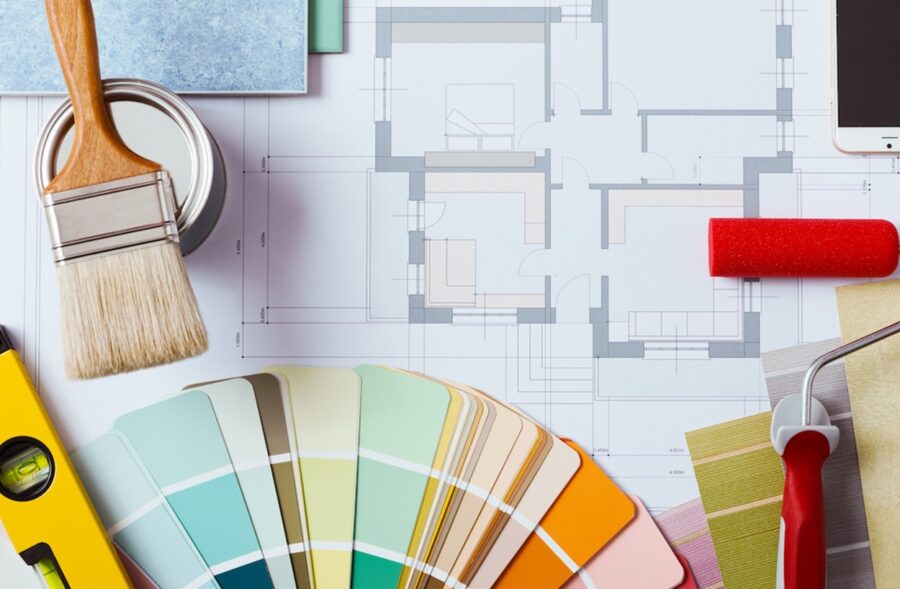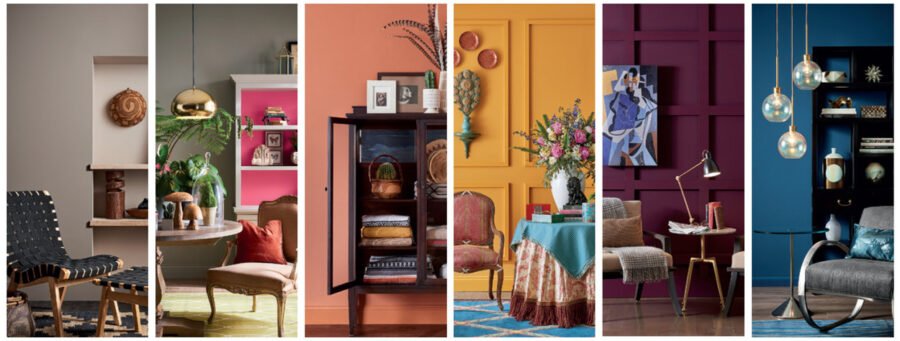Interior design is a creative field of designing and completing a space reflecting individuality. It amalgamates all minor elements to make it a whole from the parts. Color is known to be one of the most important elements that require special attention and time from the designers. The selection of the right colors in interior design is of utmost importance as per the need and to create a mood for the designed scheme.
Color can make a person feel warm and calm while on the contrary, it can make them feel deprived and depressed, it all depends on the selection of color based on personality, need, and function of the space.

Table of Contents
Importance of Color
Colors not only make a space look captivating but also affects our mood. Every color has its role to play in each varying functional space. All colors and their meaning vary as the nature and function of the space varies. Colors also tend to change the size of the space, making it look smaller or bigger based on the selection. It can make volume look bigger or smaller.
Color can change the perception of space. The height, breadth, and length could be perceived differently than usual. Colors are indeed inseparable elements of human life. Since ancient times, colors have had their significant importance from the culture to the mental well-being of humans.
Natural light also plays a role in the perception of space with colors. For instance, as in tropical regions of the world, the morning and evening light is soft and gentle, while the midday light is bright and slightly harsh. While south-facing rooms get light all day and are constantly changing, they do not receive natural light from the sun until the middle of the day when it becomes unpleasant. The warm light of the rising and setting sun is present in both East and West. Ideally, south-facing rooms should have light, cold colors, whereas north-facing rooms should have warmer hues.
Role of Different Colors in Interior Design
The more the color is brighter it adds energy to the space while the more color is subtle and light it will make a space feel calmer. So, it is obvious for a healing environment has subtle and light colors as it creates a relaxing environment.
Here, with some of the most used colors and the way that colors affect humans,
Red
Red is the most vibrant color associated with human emotions like joy, love, passion, energy, courage, danger, and hunger at last. Red, represents anger and revenge, however; it balances with its tints and shades, with tints being calming while shades with productivity.
Although, the red color has also significant cultural importance. In Indian culture, color is associated with purity, representing power, vitality, and creativity. While in Chinese culture, red is the luckiest color and purest color. It is regarded as auspicious color.

Blue
Blue is one of the most calming colors on the palette. With psychological considerations, blue relaxes the mind and tends to slow the heart rate, metabolism, and blood pressure too. The human emotions associated with the color are calmness, intelligence, prosperity, and health.
In Eastern cultures, blue is associated with paradise, immortality, and spirituality. And in Hinduism, the hue is connected to Krishna, who personifies pure love and joy. Latin American cultures, which have a sizable Catholic population, also connect the color blue to religion because it is the hue of the Virgin Mary’s cloak.
Yellow
Yellow is indeed regarded as the most energetic color on the palette. Yellow is a color that represents joy, optimism, and inventiveness. It may increase mental activity and support a cheerful disposition. Yellow is frequently used to draw attention or convey warmth. On the other hand, too much yellow can be overwhelming and induce anxiety.
Yellow color is associated with purity for Hindus. While for Egypt and Latin America, it is linked to death and mourning.
Green

Green is frequently linked to harmony, balance, and nature. It is regarded as calming and revitalizing. Green can also represent rebirth, fertility, and expansion. It is frequently utilized in environments or to promote relaxation. Green, though, can occasionally be connected to resentment or inexperience.
The color is of rebirth and prosperity in many cultures. Green is scared color in many cultures.
White
White is thought to represent innocence, simplicity, and purity. It could give off an air of sterility and cleanliness. White is frequently used to imply neutrality or space. However, it can also be interpreted in some situations as being icy or sterile. White is universal neutralizer color. Currently, different shades of white are trending, also it can be paired with any color creating an impactful space and environment which is both calm and energetic.
Black
Black is one of the most powerful colors and is often associated with power, elegance, and sophistication. It can evoke a sense of mystery and authority. Also, it indicates simplicity and functionality. In particular, the kitchen, living room, dining room, and bathroom benefit greatly from the use of the color black in interior design. With this color scheme, the form accommodates function and follows current trends in a simple design.
However, in some cultures, black can also be associated with sadness or mourning, so its interpretation can vary.
Impact of Color on Space
The use of color in the space makes it feel large or small depending on the use of warm or cool colors, tints, and shades. A variety of useful effects can be produced through the thoughtful application of warm and cool hues as well as light and dark tones. Large areas can be made to feel less vast by using warm, advancing colors and high color contrasts, whereas small spaces can be made to feel more spacious by using cool, receding colors with low contrast between them.
A high ceiling can be made to appear lower by using advancing colors, while a high ceiling can be made to appear higher by using receding colors on the uppermost portion of the wall. Using progressing colors on the small walls of long, narrow areas can help them feel less like a corridor.




